December 14, 2020
Employment growth in the euro area and EU
The euro area and EU observed its strongest increase in number of persons employed since time series started in 1995. It was noted that, in the second quarter of 2020, employment reduced by 3.0% in the euro area and by 2.8% in the EU. However, the number of employed persons rose by 1.0% in the euro area and by 0.9% in the EU in the third quarter of 2020, compared with the previous quarter.
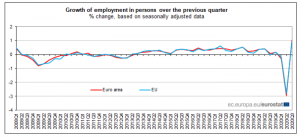
In comparison with the same quarter of the previous year, it was noted that in the third quarter of 2020, employment reduced by 2.3% in the euro area and fell by 2.0% in the EU. Also, In the euro area and EU Eurostat observed a -3.1% and -2.9% respectively in the second quarter of 2020.
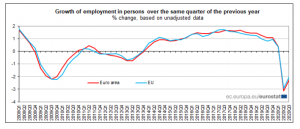
According to the Eurostat, “While the impact of the COVID-19 pandemic on employment in persons was mitigated by government support schemes, the changes in hours worked were much more pronounced.” It was noted, hours worked rose by 14.8% in the euro area and by 11.9% in the EU in the third quarter of 2020, compared with the previous quarter. Compared with the same quarter of the previous year the declines were 4.5% in the euro area and 3.7% in the EU respectively.
Employment growth in Member States
In the third quarter of 2020, Ireland (+3.3%), Spain (+3.1%) and Austria (+3.0%) recorded the highest growth compared with the previous quarter.
Meanwhile, the largest decreases were recorded in Lithuania (-1.9%), Romania (-1.0%), and Bulgaria (-0.5%). The decrease in hours worked was generally much more pronounced for all Member States.
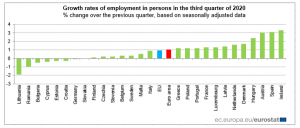
Employment levels in the euro area and EU
Furthermore, Eurostat explained that based on seasonally adjusted figures, estimates for the third quarter of 2020, illustrated that 205.2 million people were employed in the EU, of which 157.4 million were in the euro area. Also, in relation to the COVID-19 pandemic, employment in persons is 3.6 million in the euro area (-2.2%) and 4.3 million (-2.1%) in the EU below the level of the fourth quarter of 2019 . Compared to the fourth quarter of 2019, the number of hours worked was 4.6% lower in the euro area and 3.6% lower in the EU.
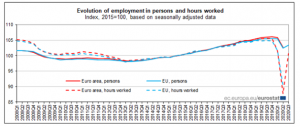
Evolution of labour productivity in the euro area and EU
“The combination of GDP and employment data allows an estimation of labour productivity. The analysis of growth compared to the same quarter of the previous year shows that productivity growth (based on employed persons) fluctuated around 1% for both zones between 2013 and 2018,” as per Eurostat.
Furthermore, Eurostat stated, “In relation to the COVID-19 pandemic, productivity based on persons recovered from the previous sharp drop in the third quarter 2020, but remained negative compared to the same quarter of the previous year with -2.2% for the euro area and -2.3% for the EU.”
Based on hours worked the impact on productivity was more limited. In the euro area there was a marginal increase in productivity based on hours worked compared to the same quarter of the previous year of 0.4%, while for the EU productivity declined slightly by 0.5%.
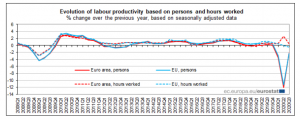
Disclaimer:
Analyst Certification -The views expressed in this research report accurately reflect the personal views of Mayberry Investments Limited Research Department about those issuer (s) or securities as at the date of this report. Each research analyst (s) also certify that no part of their compensation was, is, or will be, directly or indirectly, related to the specific recommendation(s) or view (s) expressed by that research analyst in this research report.
Company Disclosure -The information contained herein has been obtained from sources believed to be reliable, however its accuracy and completeness cannot be guaranteed. You are hereby notified that any disclosure, copying, distribution or taking any action in reliance on the contents of this information is strictly prohibited and may be unlawful. Mayberry may effect transactions or have positions in securities mentioned herein. In addition, employees of Mayberry may have positions and effect transactions in the securities mentioned herein.
